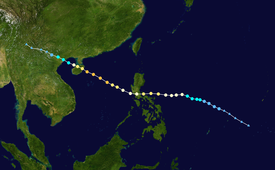| Category 3 typhoon (SSHWS) | |
 Surface weather analysis of Typhoon Winnie over the South China Sea on July 1 | |
| Formed | June 24, 1964 |
|---|---|
| Dissipated | July 4, 1964 |
| Highest winds | 1-minute sustained: 185 km/h (115 mph) |
| Lowest pressure | 968 hPa (mbar); 28.59 inHg |
| Fatalities | 120 direct |
| Damage | $30 million (USD) |
| Areas affected | Philippines, South China, Vietnam |
| Part of the 1964 Pacific typhoon season | |
Typhoon Winnie, known as Typhoon Dading in the Philippines, [1][2] formed from a mid-Pacific trough on June 21. The system moved west-northwest, passing near Ulithi on June 25. On June 26, the disturbance developed into a tropical depression and gradually took on a more westward course. Winnie reached tropical storm strength on June 27 and then typhoon strength on June 28 as it rapidly intensified en route to southern Luzon. The typhoon made landfall in Calabarzon, Philippines, on June 29 with sustained winds of 165 km/h (105 mph). Its eye passed directly over Manila. Winnie weakened as it moved over Luzon but restrengthened upon reaching the South China Sea. The typhoon reached its peak intensity with winds of 185 km/h (115 mph) and a central pressure of 945 hPa (mbar; 27.91 inHg) on July 1. Winnie made landfall on Hainan, China, on July 2 with winds of 175 km/h (110 mph). The typhoon weakened to a tropical storm as it crossed Hainan and the Gulf of Tonkin. Winnie made its final landfall near Haiphong, Vietnam, on July 3. The system dissipated on July 4 over northern Vietnam.
Meteorological history

Tropical storm (39–73 mph, 63–118 km/h)
Category 1 (74–95 mph, 119–153 km/h)
Category 2 (96–110 mph, 154–177 km/h)
Category 3 (111–129 mph, 178–208 km/h)
Category 4 (130–156 mph, 209–251 km/h)
Category 5 (≥157 mph, ≥252 km/h)
Unknown
 Extratropical cyclone, remnant low, tropical disturbance, or monsoon depression
Extratropical cyclone, remnant low, tropical disturbance, or monsoon depressionWinnie originated from a mid-Pacific trough, which organized into a cyclonic circulation on June 21 west-southwest of Pohnpei.[3]: 86 This initial system moved towards the west-northwest, passing near Ulithi on June 25. The next day, the disturbance developed into a tropical depression and gradually took on a more westward course. Winnie reached tropical storm strength on June 27 and then typhoon strength on June 28 as it rapidly intensified en route to southern Luzon.[4][5]: 74 The typhoon attained sustained winds of 165 km/h (105 mph) shortly before moving ashore Calabarzon on June 29;[4] its eye passed directly over Manila.[6] Winnie weakened as it moved over Luzon and restrengthened upon reaching the South China Sea, taking a west-northwesterly heading.[4][5]: 74 There, Winnie reached its peak intensity with winds of 185 km/h (115 mph) and a central pressure of 945 hPa (mbar; 27.91 inHg). At 00:00 UTC on July 2, the typhoon made landfall on Hainan southwest of Wenchang with winds of 175 km/h (110 mph). Winnie weakened to a tropical storm and traversed Hainan and the Gulf of Tonkin before making a final landfall near Haiphong, Vietnam, on July 3. Further weakening ensued as the system tracked across northern Vietnam and southwest China before dissipating on July 4.[4]
Preparations and impact
China
Philippines
Manila experienced its most damaging typhoon since 1882. Nearly a million people were affected by the storm; according to the U.S. Agency for International Development (USAID), there were 56 fatalities and 163 injuries as a result of Winnie in the Philippines, with a damage toll of US$8 million.[7][8] However, the Associated Press reported 89 fatalities on July 3 while United Press International reported 120 fatalities on July 5, with property damage estimated at over $30 million.[9][10][11] The Red Cross enumerated 275 injuries.[12] Heavy rains from the combination of Winnie and the southwest monsoon flooded entire neighborhoods in Manila.[13] At least 10 people were killed by flooding rivers near Manila and in Manila Bay.[6] Approximately 500,000 people were rendered homeless in the Manila area and in the central provinces of Luzon following the razing of thousands of homes;[14][5]: 74 most of these homes were nipa huts and "makeshift dwellings". Approximately 120,000 homes were destroyed in Bataan, Bulacan, and Pampanga.[15] The loss of roofs was widespread.[13] Thousands of trees were uprooted and basic utilities were brought down by the storm;[16] Manila was without power or water for at least 36 hours.[12] In Infanta, Quezon, a maximum wind of 127 km/h (79 mph) was measured.[17] Abaca and coconut plantations in Luzon were seriously impacted. Cargo barges and freighters broke from their moorings and a Philippine Navy destroyer, the RPS Rajah Soliman, capsized while undergoing repairs.[12][6][15] Several aircraft were damaged, including 15 C-47 Skytrains at Nichols Field.[6][5]: 74 The air traffic control tower at Manila International Airport was put out of commission following wind damage.[6][18] Manila was placed under a state of emergency following Winnie, with government agencies deploying medical and rescue teams to affected areas amid widespread power outages.[12] Catholic Relief Services aided in disaster relief with funding from USAID.[19]
Vietnam
South Vietnam delivered 450 metric tons (500 short tons) of rice to victims of the storm in the Philippines.[20] Dikes and salt fields were damaged in two districts of Nam Định, Vietnam.[21]

